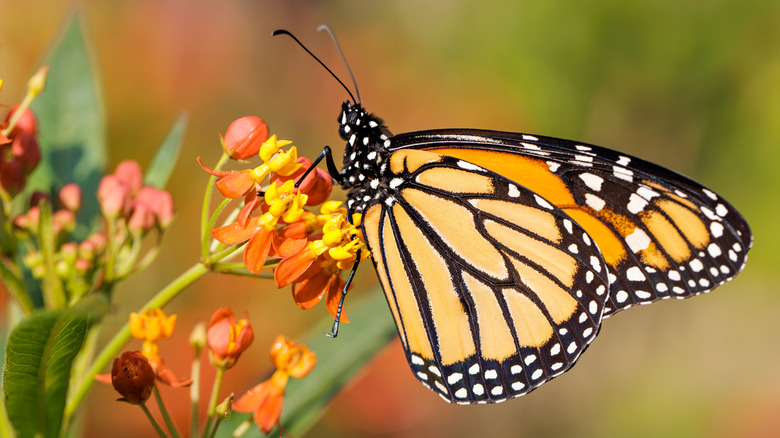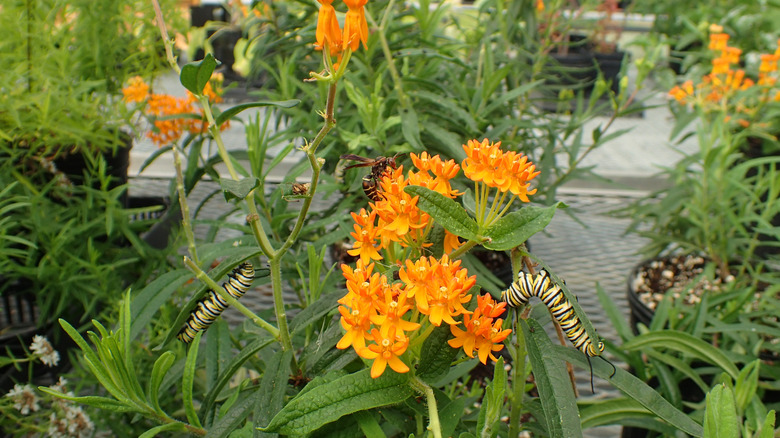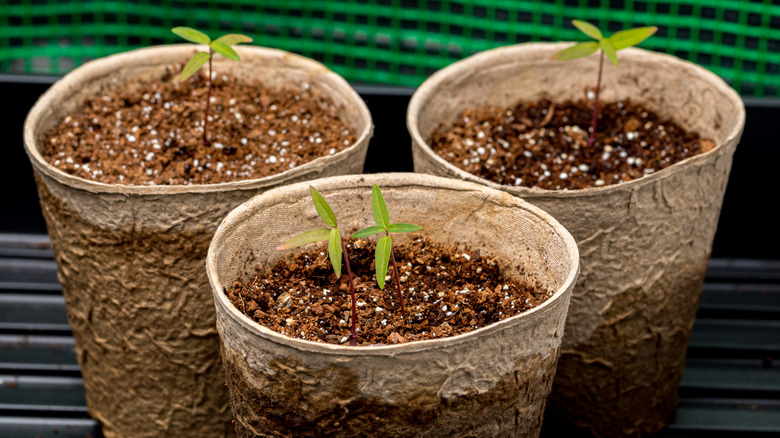The Milkweed Mistake That Could Cost You Monarch Butterfly Visitors In The Garden
If you are planting milkweed to attract monarch butterflies, you are already ahead of the game. But even the most well-meaning gardeners can make critical mistakes when planting milkweed that may send these pollinators elsewhere or, worse, kill them unintentionally. One of the most common problems is choosing the wrong type of milkweed for your region. Tropical milkweed (Asclepias curassavica), widely available at garden centers, is native to the Caribbean, central and South America, and Mexico, and is sold as an annual in northern areas of the US. Its bright orange and yellow blooms are striking, and many gardeners recognize the importance of growing milkweed, but planting it in temperature regions can do more harm than good.
Tropical milkweed doesn't die back in cooler climates the way native varieties do. As a result, monarchs may stay on the plant longer than they should, delaying their migration and increasing their risk of disease, particularly the parasite OE (Ophryocystis elektriscirrha), which builds up on plants that don't go dormant. Planting non-native milkweeds outside their natural range disrupts the monarch's instinctive life cycle. The solution is to buy the variety of milkweed that is native to your county. With over 70 species of native milkweed, there are many options, no matter where you are gardening. If you have already planted tropical milkweed and live in an area where it doesn't die back, cutting it to the ground in late fall mimics dormancy and reduces parasite risks. Then, you can replace it with regionally appropriate species going forward.
The hidden danger in store-bought milkweed
Even when gardeners know the benefits of growing milkweed and choose the right species of native milkweed to support monarch butterflies, there is another serious threat lurking in plain sight: pesticide exposure. Many commercially grown milkweed plants, especially those sold at big box stores, are pre-treated with systemic insecticides, including a class known as neonicotinoids. These chemicals are absorbed into every part of the plant, from roots to flowers, and can remain active for weeks or even months after purchase.
Neonicotinoids, or 'neonics,' are highly toxic to pollinators like monarch caterpillars and adult butterflies. Consuming milkweed leaves or nectar from plants treated with neonics can be lethal. Even sublethal doses may impair a butterfly's ability to navigate, reproduce, or survive migration. To make this more complicated, treated plants are often unlabeled. That means that even a well-intentioned gardener may accidentally introduce harmful chemicals into their pollinator habitats. To avoid this risk, ask retailers whether their plants have been treated with neonics. If they can't confirm, consider shopping from a local native plant nursery that uses organic or pesticide-free growing methods.
How to grow your own native milkweed from seed
One of the best ways to ensure your milkweed is truly pollinator safe is to grow it yourself. Starting native milkweed from seed may take a little patience, but it guarantees your plants will be free from harmful pesticides and perfectly adapted to your garden's conditions.
The key to success with milkweed is cold stratification. In nature, milkweed seeds go through a cold winter before germinating in the spring. If you sow your seeds in the fall, nature will do this for you. Alternatively, if you are starting your seeds in the spring, you can mimic this process by placing seeds in a damp paper towel inside a plastic bag and storing them in the refrigerator for 30 to 60 days.
After stratifying, plant your seeds in a sunny location with well-drained soil. Direct sowing in early spring works well, or you can start seeds indoors a few weeks before your last frost date. Keep the soil slightly moist while seeds are germinating, which may take two to four weeks depending on the species. Once established, milkweed plants are drought-tolerant and low-maintenance. From there, allow your milkweed to self-seed by resisting the urge to deadhead the flowers. Milkweed is one of the best plants for your pollinator garden, so it's important to get them off to a great start.


